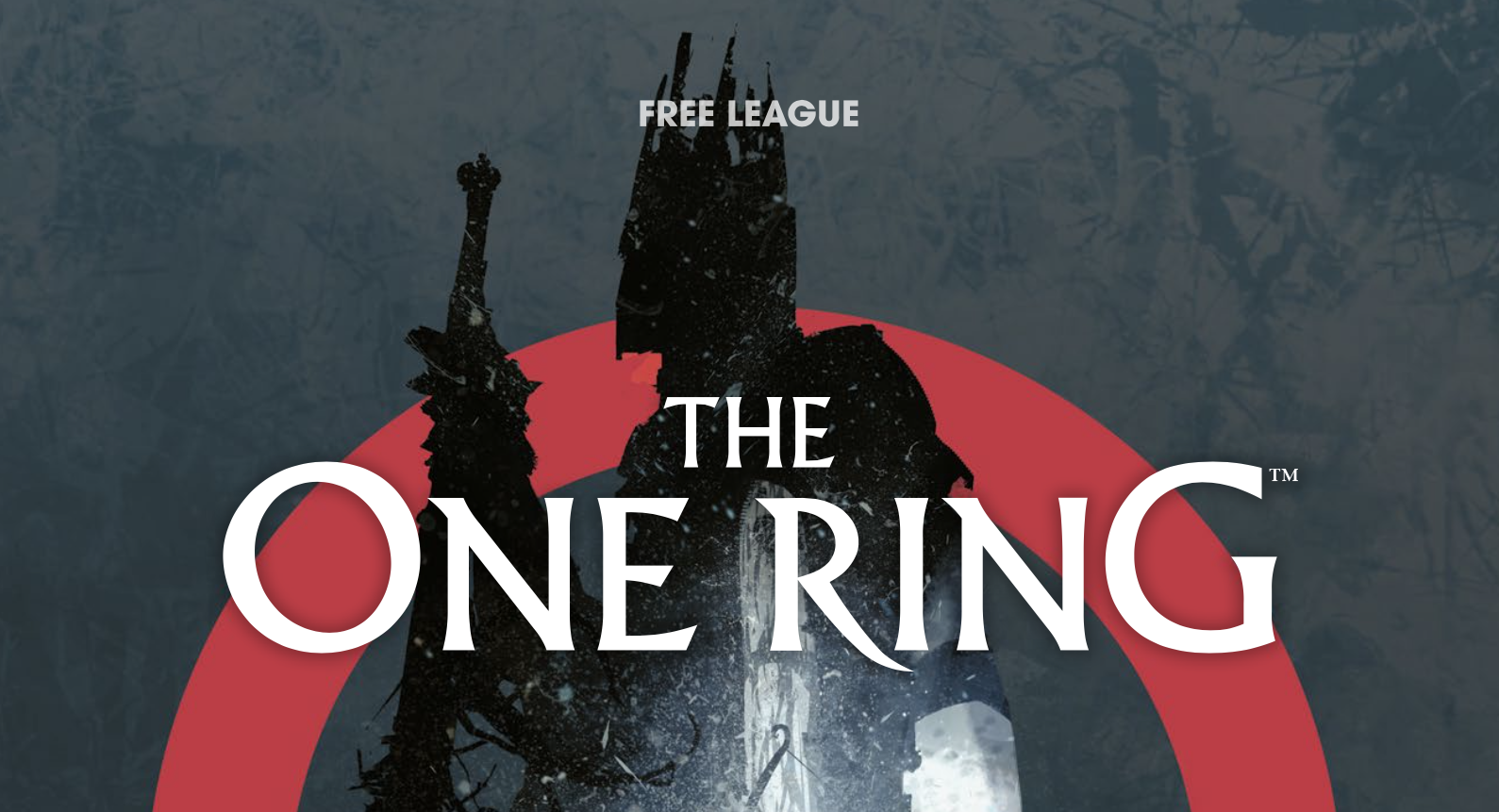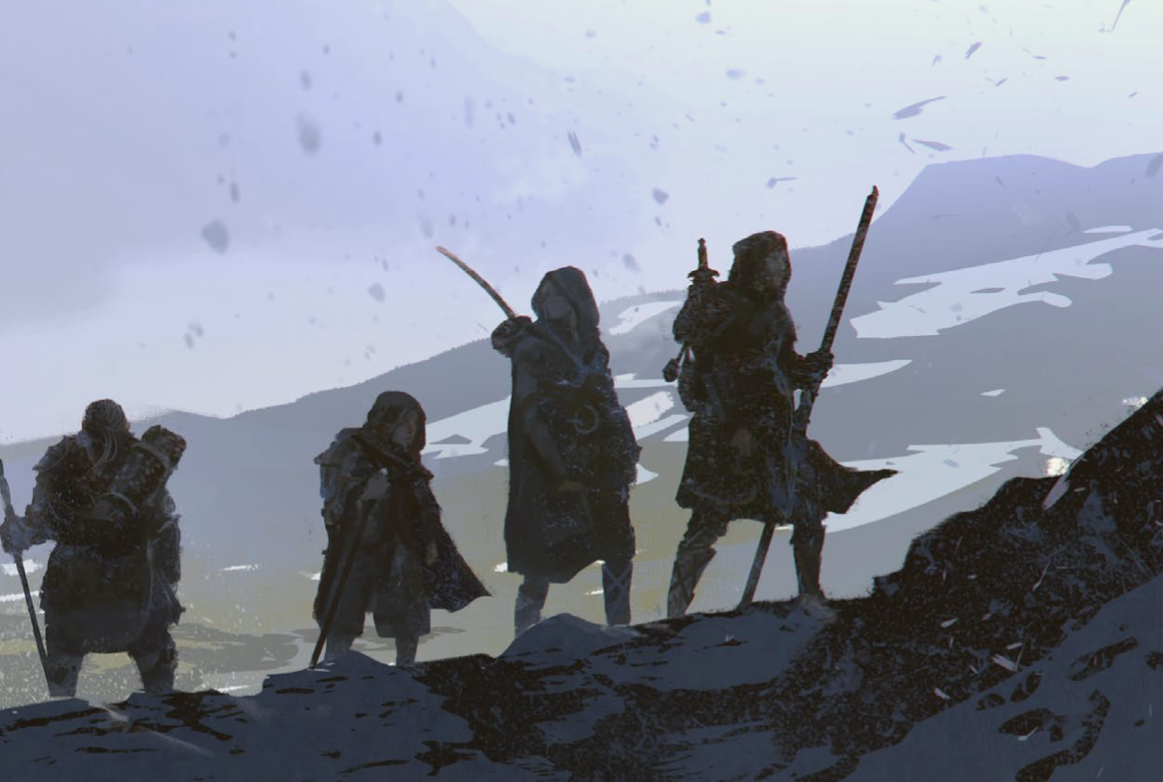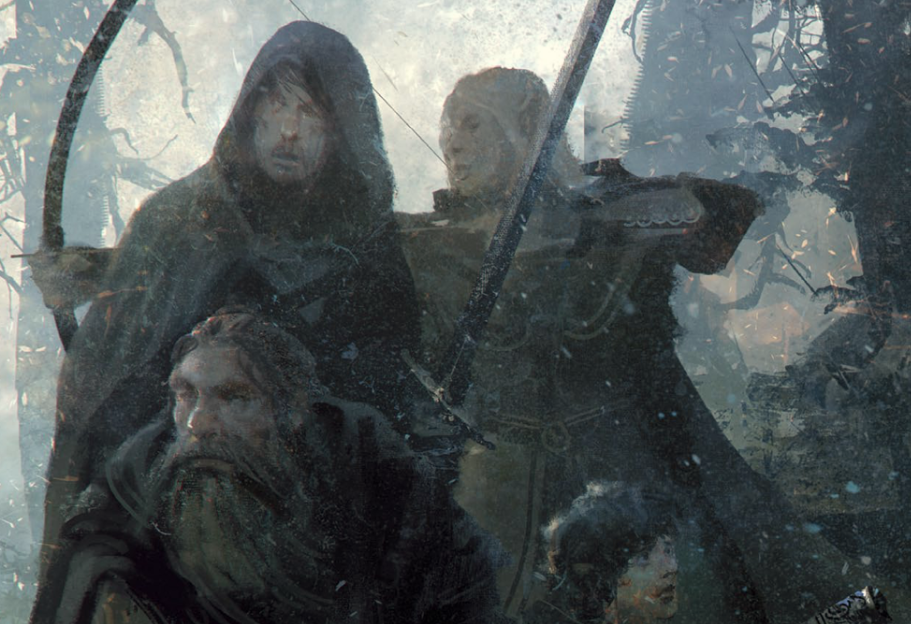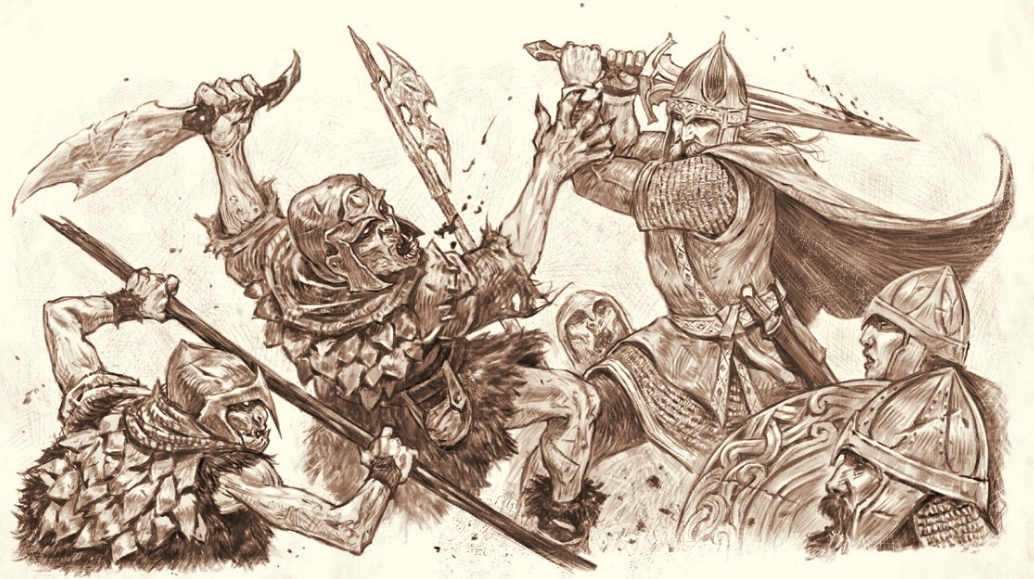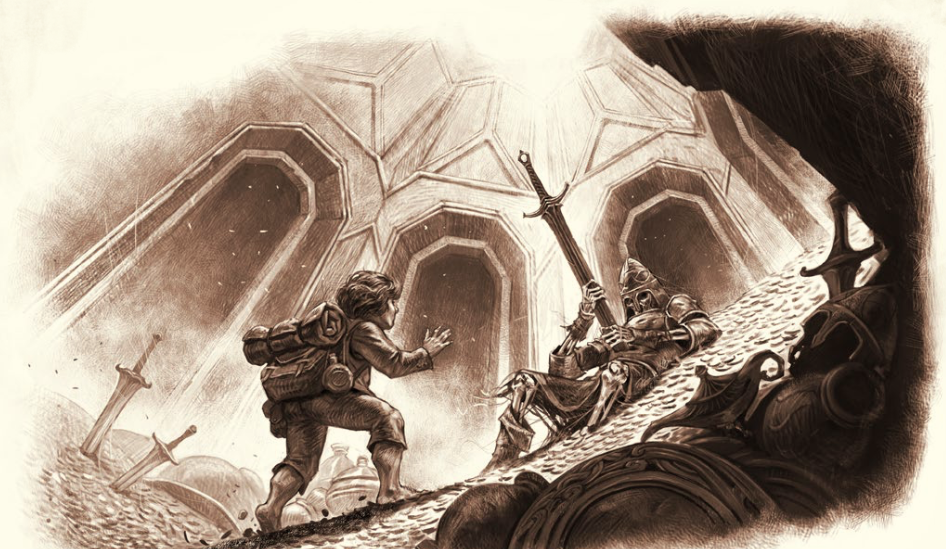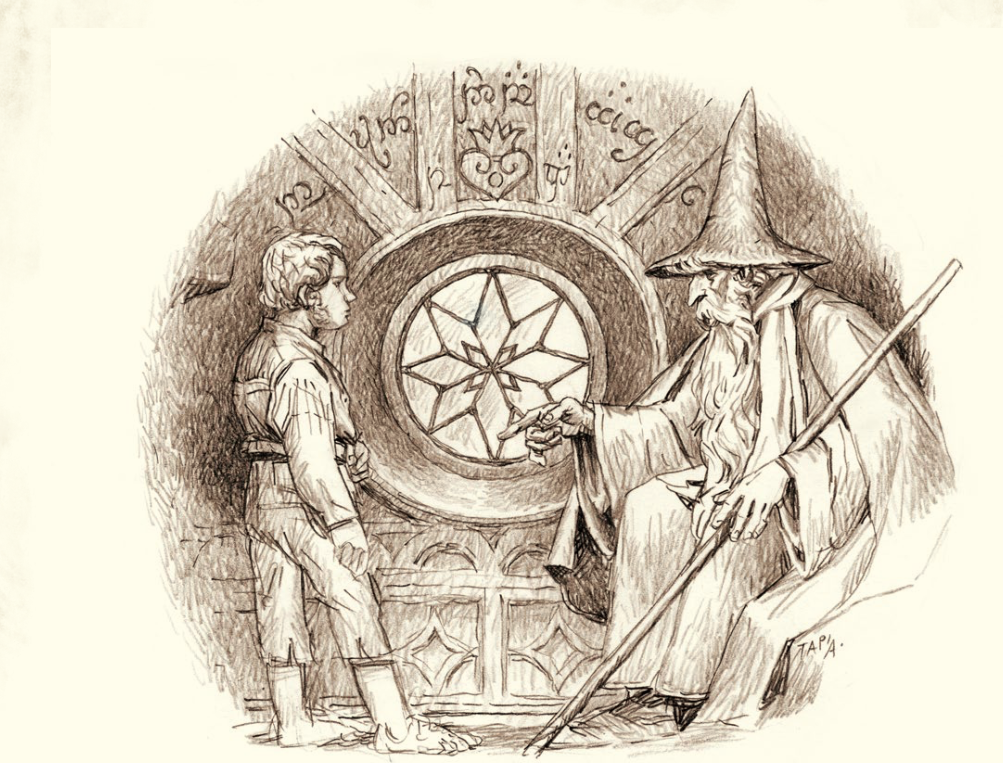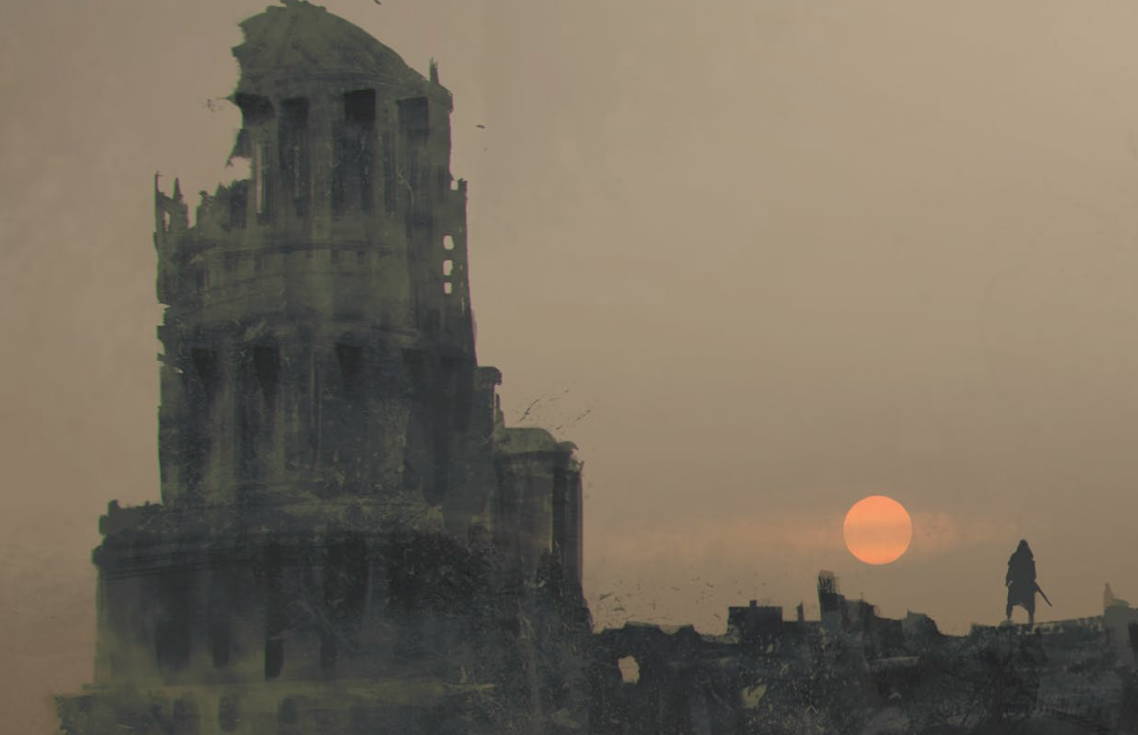The One Ring RPG 2nd Edition: First Impressions of the Lord of the Rings Roleplaying Game from Free League Publishing
The Cover of Free League’s 2nd Edition of The One Ring RPG
When something on Kickstarter gets funded in 4 minutes, it must be a good idea.
And a 2nd edition to The One Ring RPG is definitely a good idea.
God knows the fanbase has been waiting and hoping it would happen. And, it has!
But what's going to change in The One Ring RPG 2nd edition?
Let's find out.
I'm one of the backers of Free League Publishing on Kickstarter and got my copy of the alpha version of the core rulebook to this new Lord of the Rings roleplaying adventure. That means I get some of the first peeks inside the shiny 2nd edition.
But I ain't greedy. I want you to be able to see a glimpse at what changes, too, if you weren't a backer or don't want to sift through the entire rulebook.
With some experience running the 1st edition in The Party Business Podcast, some of the changes I noticed reading through the 2nd edition rulebook already have me excited.
But blah blah blah, let’s get to the specifics...
(And it's a doozy of an article, so you can use this table of content below to help guide you.)
Table of Contents
Changes to Journey Mechanics in The One Ring RPG 2nd Edition
“Uhh why is the sun sinking in the East…oh no.” Credit: The One Ring RPG 2nd Edition Rulebook
Let's be honest, this is probably what you were most curious about and the first section I scrolled down to when I got the alpha version of the rules.
It's a lot better now, in my opinion.
You'll see a theme as you read through each of these tweaked rules, and that's streamlining.
One of the issues with the 1st edition of The One Ring RPG is that it had some convoluted mechanics for certain things in an attempt to make them immersive. Sometimes it worked (and when I talk about leveling up skills, you'll see what I mean.) Most of the time, though, it took away from the immersion, ironically.
Journeys in The One Ring RPG were one of those things.
There was a lot of math and hex counting and taking into account what kind of area the group was going through and the time of year and it formed this big formula that’s even longer than this sentence.
Then, fatigue rolls, travel gear weight, and the burden of your weapons and armor added to the mix.
So much to keep track of! Too much.
The new rules simplify it while still keeping the core of what Journeys were supposed to be about. After all, Journeys were really about making Middle Earth feel real, dangerous, and a hell of a lot of fun.
The basics are the same in the 2nd edition of The One Ring RPG.
There are 4 roles the player characters fill:
Guide
Scouts
Hunters
Look Outs
Then the players choose the route they want to take on a map. So you still get to use maps and feel like you're really planning an adventure.
There's even a cool player sheet specifically for Journeys that acts as a travel log. (And I'm a slut for maps, so anytime a game can make that more tactile, I'm going to be a fan of it.)
The example from the rulebook. Credit: Free League Publishing’s 2nd Edition of The One Ring RPG
Then you need to see how many events happen along the way.
That's where the Guide role comes in. The Guide rolls to see how successful the start of their journey is. The better the roll, the farther the group will go before an event happens. This is influenced by the time of year. Winter won’t get you as far as summer if your Guide is falling down on the job.
When an event does take place, that's where the Loremaster comes in. (And remember, Loremaster is the fancy term for Dungeon Master in The One Ring RPG.)
The Loremaster rolls to see which of the party members the event targets. There's an event table to roll on so that you can see what the consequences are for the event.
As it stands right now, there’s not a whole lot of flavor text to help a Loremaster get creative with the events. That might change as the rules get completed, or extra material gets made. (1st edition of The One Ring RPG had extra material for Journeys too.)
And the event table makes for boring play, in my opinion, if it’s used without any imagination. You roll on the feat die (12 sided dice), see what kind of danger will happen, roll to see if you succeed or fail, then move on.
If the Loremaster isn't careful, that could make things lackluster.
I'm always a fan of roleplaying things out. I would even make everyone roll and whoever fails has the challenge happen to them. Then I would tailor that event to the role of the target. If it’s a Scout, for example, then it might be an event based on making camp in a cave that they thought (wrongly) was uninhabited.
I like giving my players as many chances as possible to influence the story.
Once the event is resolved, and the group overcame or failed while gaining some penalties, the Guide rolls again to see how far the group gets before the next event.
Then you keep doing that until you reach your destination. There's no math to consider, no formulas, just a simple roll, and the group keeps moving.
I would love to see this keep getting built upon, but I'm a big fan of the streamlining here. Honestly, so much so that I'm probably going to immediately start implementing it in our One Ring RPG podcast, The Party Business Podcast.
Fatigue still plays its part too. Endurance in The One Ring RPG represents a character's health bar (more or less) and how much they can carry.
Fatigue works against that stat. If Fatigue overcomes Endurance, the player becomes Weary, and you don't want that.
Journeys, naturally, are tiring. As players gain Fatigue through failed or mixed success events, they track their total. At the end of a Journey, the players roll Travel skill tests and see how much they can remove. The better the roll, obviously, the more that gets taken off.
If the players have mounts, they automatically reduce some of that Fatigue.
Whatever Fatigue is left works against a player's Endurance. Every long rest will help recover that slowly.
Overall, Journeys now have a more linear sense to me. You do things mostly with rolls, there's still enough room for roleplay, and the better the players do, the more they help themselves out in the end.
It would be nice to have some specific events gathered up like we had in the 1st edition of The One Ring RPG, but that probably will come with time.
And that just means Loremasters get to write some scenes!
Gaining Shadow Points In The One Ring RPG 2nd Edition
Aaand you all fail your Awareness rolls. Good luck! Credit: The One Ring RPG 2nd Edition Rulebook by Free League Publishing
One of the biggest things that makes The One Ring RPG unique is Shadow Points.
Have enough terrible things happen to your character, and they have a bout of madness. Think Boromir at the end of The Fellowship of the Ring.
If that happens enough, your character is done. Retired. Sailed into the West. Swimming in a pool that’s nice and cool. Whatever form being done adventuring takes.
Shadow Points are still a thing in the 2nd edition of The One Ring RPG, thankfully.
But they get a tweak too.
The biggest change is that the character is in charge of their own bout of madness. In 1st edition, the Loremaster took control of the character and told them what happened. I never like when the GM takes control of a player's character.
That's now fixed, rules as written.
When a character earns enough Shadow Points to match or exceed their Hope stat, they become Miserable, just like in 1st edition. But now the player decides how that bout of madness happens because that's the only way to reduce Shadow Points when it overcomes their Hope score.
The bout has to happen on the adventure because if the player comes back Miserable, they will leave the Company and retire. (Which I don't particularly like, but it's sure an incentive for players to just get it over with.)
There's also a way out before you hit that point of no return with your Shadow Points. You can now harden your will. It clears your Shadow Points but gives you a permanent Shadow Point you can only get rid of at a high price in a Fellowship Phase (more on Fellowship Phases later.)
If you get enough of those, it will be hard to play without constantly overtaking your Hope score, so use that sparingly.
I LOVE that there are options, though.
The bout of madness will have consequences and move you down your character's Shadow Path. You still are forced to retire if you reach your max number of madnesses.
Damn, that sounds like a speed metal band. Max Number of Madnesses!
Shadow Points have different sources that require different rolls to pass the tests (Valor and Wisdom.) Those sources can be Dread, Greed, Misdeeds, and Sorcery. And there are charts for the severity of the terrible thing that happens with increasing levels of Shadow Points players are cursed with.
The more successful the Valor or Wisdom roll is, the more Shadow Points are negated.
Overall, this new way of using Shadow Points makes it easier for the Loremaster to know when players get Shadow and how much they should get. That way, the players can start getting wise and understand how the mechanics of it works so they can strategize around it.
Again, I think I will implement that right away in The Party Business Podcast, where we’re still using 1st edition rules for The One Ring RPG. (We are recording episode 9 next, so those changes won't show up until then if you want to see how some of these mechanics work in action.)
Character Creation Changes in The One Ring RPG 2nd Edition
The group always makes sure they look cool before killing orcs. Credit: Free League Publishing’s One Ring RPG 2nd Edition
Let's face it, character creation is half the fun of any good tabletop RPG. The One Ring RPG is no different.
There are some tweaks to creating your character in 2nd edition, but it's heavily influenced by 1st edition.
You still have, more or less, the same skills to invest in, attributes, cultures, and callings. And you even build your character similarly to 1st edition of The One Ring RPG.
How all of those things work with each other and where they show up in gameplay sees some changes.
Most obviously, there are new cultures and callings in The One Ring 2nd edition because it's set in a different part of Middle Earth than the initial release of 1st edition. You'll be adventuring on the west side of the Misty Mountains, around Bree, Rivendell, and Eriador at large.
So, cultures are different simply based on that. Here's what's available in the alpha version of the rulebook:
Men of Bree
Dwarves of Durin's Folk
Elves of Lindon
Bardings (which surprised me considering how far their home is from Bree)
Hobbits of the Shire
Each has its own unique skill sets, traits, attributes, and all that good stuff.
And the Callings, that act as Classes in The One Ring RPG, also got an update:
Captain
Champion
Messenger
Scholar
Treasure Hunter
Warden
These are primarily based on what we got in 1st edition.
But what struck me as a huge gameplay shift was how Attributes work.
Attributes are general representations of a player's physical and mental prowess combined with how passionate, hopeful, cheerful, or kind they are.
All this is represented by Strength, Heart, and Wits. (Strength was Body in 1st edition.)
Those played a confusing role in the 1st edition of The One Ring RPG.
They added to your skill rolls when you became hopeful. There was a different score based on your favorite skills, and sometimes they played into other things. It was kind of a mess and hard to remember how they played into gameplay for a newbie.
(Side note: favorite skills are better now too. You get to roll with advantage when using favorite skills. Ok, back to Attributes.)
But now Attributes play a more prominent role (roll actually.)
In the 2nd edition of The One Ring RPG, Attributes determine how hard it is for skills associated with that Attribute to pass the Target Number. Target Number being the DC for D&D fans–the number players have to hit for a success.
Whatever your Attribute is, you subtract that number from 20, and now you have your base Target Number (TN) for any of the skills under that Attribute.
So if you have 7 Strength, that means your TN for any of those skills will be 13 (20-7.) So Awe, Athletics, Awareness, Hunting, Song, and Craft all have to hit or beat 13.
Side note: I liked it better when Strength was called Body because it reflects more the total senses, energy, and physicality your body has to perform for those skills. It's not all just “strength,” but I digress.
The Loremaster can still say a TN is harder based on a situation. So if you're trying to impress someone with a song that hates your guts, the TN might be higher, or you might lose a dice to roll with as a disadvantage. But for the most part, the player will always know what they have to beat.
I don't know if I like that as a Loremaster. But, I am very curious to play with it. And I'm happy the Attributes play a bigger part.
They will also determine your base Endurance, Hope, and Parry ratings.
And the Strength attribute is a pretty big deal in combat if you want to hit anything.
Which brings us to...
What Makes Combat Different in The One Ring RPG 2nd Edition?
Me when someone says Harry Potter is better than The Lord of the Rings. Credit: The One Ring RPG 2nd Edition Rulebook by Free League Publishing
Attributes. Or at least they are more involved in combat from the get-go in 2nd edition.
That Strength Target Number is what you need to score a blow against an enemy. If the enemy has a Parry score, that's added to that TN, but otherwise, it’s on the combat prowess of the player to hit.
I like that a lot. It’s a balance of the skill of the user, the Attribute, the skills of the enemy, and luck. In a fight that's happening with only seconds to make decisions, that seems to make a lot of sense to me.
The most important thing about combat is that it still stays super deadly. What I loved right away in The One Ring RPG is that combat can go very bad, very quickly. The threat of death is always there, and that's realistic.
A group in D&D might encounter 7 goblins, and even if they are level 1, they won't be all that worried. They encounter 7 goblins in The One Ring RPG, and it might just go bad no matter how many skill points they invested in their combat skills.
Now, a higher-skilled combatant with great armor and some reward traits added to their weapons will be a lot more confident. But the threat of getting 2 wounds is always there.
(Wounds, remember, are when an enemy gets a Piercing Blow with a good roll and beats your armor score. Wounds have severity levels now in 2nd edition, and there's new rules for how they affect monsters too.)
Get 2 wounds, and your character is down. If that second wound also takes you to zero Endurance, you're dead. Done. Kaput. Finished. Just like that.
It makes even a skilled group wary of running into a dangerous situation and allows for roleplay mechanics to add more strategy to an encounter.
Even in 1st edition, I got to see this play out. In The Party Business Podcast, our group finds themselves trying to free someone from a spider nest. Instead of rushing in knowing that they can take some spiders no prob (like they probably would have done in D&D), they decided to plan and be sneaky.
One character rode the spider web down a wall, another set it on fire, and a third covered their escape while everyone else wheel borrowed the captive out of there, and it made for incredible roleplaying.
The 2nd edition of The One Ring RPG keeps that tension.
You still have the combat stances like 1st edition, which I like. Depending on the stance, those have special things your character can do, so you can start adding some tactics to the fight.
One difference about your attack rolls is that any 6's on the success dice (your d6) grants you a special attack. You can choose to spend a 6 on a heavy blow that does extra damage, or fend off the enemy giving you a parry boost, or add to your piercing blow success, etc. It makes every roll exciting, and I can't wait to try combat like this.
Piercing blows remain, although weapons no longer have edge ratings to hit. Everything is based on hitting a 10 or the Gandalf rune on the Feat Die.
Some legendary weapons and reward traits can improve that score, though.
Did I say legendary weapons?
Wondrous Items In The One Ring RPG 2nd Edition
“I’m sure this sword isn’t haunted at all. Very confident.” Credit: The One Ring RPG 2nd Edition Rulebook by Free League Publishing
My biggest beef (and there are very few) with The One Ring RPG is a criminal lack of kick-ass weapons and items.
Does this make sense in Middle Earth as the players traverse The Lord of the Rings world that Tolkien built?
Absolutely.
Do I still wish they would find that amazing item that turns the tide of the campaign?
Of course.
Well, the 2nd edition of The One Ring RPG makes up for that.
There's an entire section of the rulebook dedicated to making legendary and ancient weapons and items. Whole tables will help you create something that might give stealth advantages, make a character more awe-inspiring, or give them bonuses in battle.
Someone wearing the helm of some ancient Dwarven champion might be able to rally the others around them in combat.
There are charts to help you build characters from different ancient cultures like the Noldor Elves or the Numenoreans.
The book is very clear that there shouldn't be too many of these in a campaign. These items are rare, and when found, are a marvel of the Third Age in Middle Earth. And there's even rules on finding them.
This isn't just for weapons and armor either–you can find trinkets too. Maybe even a ring.
Your Hope score will fuel a lot of the Blessings that are attached to weapons and items. Many of these allow you to have automatic successes that are considered “magical” in some way. There's a catch though, if you show off these powerful abilities in front of others, it might draw unwanted attention.
(Which we will get to here in the next section because that’s a whole new mechanic too.)
The magical success on skills replaces the Distinctive Trait feature from 1st edition of The One Ring RPG in a way. The Traits are still there, but you have to burn a Hope point to use them with associated skills, which still just gives you an extra success dice.
Traits have always been a kind of weird thing in The One Ring RPG because they are a roleplaying mechanic more than an ability. In 1st edition, they meant possibly not having to roll at all to do something, but now it seems they have a little less power–but more definition.
I'm not sure if I'm a fan of that. I would have to play with it to see. I always liked giving my players more roleplaying opportunities and rewarding them for doing it.
But that's neither here nor there. The addition of wondrous items and legendary weapons is badass.
Honestly, it's one of my favorite features, and I'll plop that right into our campaign in The Party Business Podcast.
Drawing the Attiontion of The Eye of Mordor in The One Ring RPG 2nd Edition
“Someone pass the maggoty bread please.” Credit: Free League Publishing’s 2nd Edition of The One Ring RPG
If there's one thing that’s ever-present in The Lord of the Rings books and movies, it's the crushing weight that the Eye of Sauron is constantly hunting for the Fellowship.
And it’s so fun for everyone that Free League Publishing decided to put it into the game mechanics in the 2nd edition of The One Ring RPG!
1st edition still had Shadow, and that acted as a way to get that feeling. But it didn't feel like you were drawing the attention of the Enemy actively.
And frankly, that's probably good. At that time especially, if you were playing a campaign set about five to ten years after the Battle of the Five Armies, Sauron was very much not paying attention to that area. He had a tower to build and Gondorians to piss off.
But the 2nd edition of The One Ring RPG is set a little later. Sauron might be hunting more actively for the Ring and trying to see what any goodie goodies are up to out in the world.
Your group might be the goodie goodies he starts to loathe.
And that's cool.
And terrifying.
The mechanics of the Eye act like Shadow Points for the whole party. You start with a baseline that depends on who's in your group. A party with a couple of Hobbits and a few Breelanders isn't going to attract the attention a Ranger of the North and Elf would.
Every time a party member gains Shadow or uses a Magical Success on a skill or ability, the Eye begins looking more in their direction. There are tables and charts in the rulebook that explain how much attention the party can gain before being hunted.
Yup, hunted.
An event takes place that the group will either need to overcome or escape from, again based on the area they are in and what caused the hunt. There's also some Feat Die to roll.
It adds a level of intensity to Shadow Points too. Sure, your character might pass most of the Shadow Tests, but there are still consequences for you if your fellowship members struggle.
And that's what I love about the mechanic. It makes the players feel even more bonded to each other. Anything that will make the fellowship feel more like, well, a fellowship is probably a good thing.
After all, The One Ring RPG is all about fellowshipping.
Changes to the Fellowhip Phase in the 2nd Edition of The One Ring RPG
“Can someone pass the non-maggoty bread please?” Credit: The One Ring RPG 2nd Edition by Free League Publishing
God, I love me some good downtime in a tabletop RPG.
The Fellowship Phase has always been about the players making choices about what they want to do and how they develop their character.
Originally, in The One Ring RPG, Fellowship Phases had a lot of rules around Sanctuaries and what you could do in and out of a Sanctuary. Now, a ton of that has been simplified.
Fellowship Phases happen after Adventuring Phases as the group traveled and explored and fought the Shadow. Time to enjoy some well-deserved comforts.
The group chooses a location they have been to before. Most of the time, it will be something nearby, except at the end of the year (a Yule Fellowship Phase,) which I'll get to in a sec.
Then they get to do a few things. First, and this is different now in the 2nd edition of The One Ring RPG, they recover Hope. This happens no matter where you are as long as you are in relative safety, which should be every Fellowship Phase.
Hope recovery is based on your Heart Attribute. You won't recover all of it unless you are at the end of the year (there's a reason for that.)
The good news is you don't have to burn a Fellowship Undertaking to get some Hope back. And you get some Shadow Points taken off based on how effective you were in your Adventuring Phase as determined by the Loremaster.
None of that is tied to a Sanctuary or an Undertaking anymore, which is awesome.
Undertakings form a long list of possible things your group can do together and as individuals. From studying maps to help Journey rolls, meeting Patrons, writing songs that can help during adventures, identifying wondrous items, or recovering even more from the Shadow.
At the end of the year (typically, there's an Adventure and Fellowship Phase per season of the year), there's the Yule Fellowship Phase. This is the longest Fellowship Phase that allows the players to visit home and wait out the winter in comfort.
There are specific Undertakings that happen just for the Yule Fellowship Phase.
Every standard Fellowship Phase sees the players do an Undertaking as a group then an Undertaking as an individual that counts as a “free” Undertaking based on their Calling. In the alpha rulebook, this was unclear as to what that meant. Maybe it has to do with the Distinct Feature of the Calling, and it’s up to the Loremaster how to interpret that. But hopefully, there will be more clarification as we see the printed version made. (And if you see something that I missed, please feel free to let me know what it means in the comments.)
A Yule Fellowship allows all the players to do something individually and then get the free Undertaking too. It's supposed to represent going home and getting some much-needed chores and activities done. Plus, like, see family or whatever.
Of course, the group gets to raise their skills, Valor, and Wisdom in a Fellowship Phase too.
This is another big difference from 1st edition that I am not sure I like.
Skills Points now get gained per session of play. Or about 1 point per hour of play during an Adventure Phase. So that means you are probably coming out of an Adventure Phase with 6 to 12 points to spend–ish.
It doesn't matter how well you rolled or what traits you evoked, that’s steady for everyone. You don’t count skill group pips.
I loved how The One Ring RPG did skill upgrades in the 1st edition. How well you rolled and what you tried made you better. It seemed natural. It worked kind of like leveling up in Skyrim for those who played that. (And who hasn't?)
It incentivized the players to roll for anything they could think of. They actively tried to think outside the box, and that mechanic rewarded them.
Granted, that was a bitch to keep track of. I'm bad at remembering giving Inspiration in D&D, let alone making sure players are leveling up throughout the adventure.
It can be overwhelming, so I see why it was simplified. In the end, you could still run the leveling up the same way 1st edition did.
And you still get cool rewards and virtues for Valor and Wisdom.
Encounters Are Now Councils in The One Ring RPG 2nd Edition
“I’m not trying to rob you…you just owe me for second breakfast.” Credit: The 2nd Edition of The One Ring RPG by Free League Publishing
Councils are more specific now than the Encounter counterparts from the 1st edition. And Encounters were interactions with new people the group met to try and add some mechanics to social situations.
This was, based on special meetings in the books. In The Hobbit, Bilbo, Gandalf, and the Dwarves all met Beorn and needed to be very particular about how they did it so they wouldn’t insult and/or piss him off.
That's what this mechanic tries to represent.
Now, Councils are just for super important formal meetings rather than encounters with every new rando on the road. Unless they are Gandalf or something.
It's similar to 1st edition but simplified–which seems to be the theme for all the rules from The One Ring RPG 2nd edition.
Resistance is set for the Council. If it’s some crazy request the group is asking of Elrond, it’s going to be very hard to get him to agree or help.
The group makes introductions, rolling for certain skills like Awe or Riddle, then they move on to the interaction. The person they’re meeting with will also influence the rolls, depending on the group’s standing with them and their personality.
The introduction stage will determine how many rolls the group makes as they interact with this influential person.
Then the group keeps rolling more social skills through the interaction as they see fit.
The whole system is a distilled version of what came before that works a lot more linearly than in the 1st edition.
Once again, I'm a fan of the simplicity while still keeping the mechanic intact that makes The One Ring RPG special.
Final Thoughts on The One Ring RPG 2nd Edition
*John Williams intensifies…wait wrong geeky thing. Credit: The One Ring RPG 2nd Edition Rulebook by Free League Publishing
This is already a huge article, and even still, there's no way to jam all of the changes to The One Ring RPG 2nd edition.
There's much more I missed, but this was just from going through the alpha rulebook from Free League Publishing and writing down my first impressions.
At the end of the day, the 2nd edition leans heavily on the rules of the 1st edition of the game, which is a good thing! The transition for those who love The One Ring RPG already will be an easy one.
What has changed is mainly for the better. I expect that the gameplay will move much quicker, and things won't be nearly as taxing on players (and the Loremaster) to try and remember.
The rules from 1st edition, if we were going to think about things visually, are more...stop and go. Like everything piling up at events, and then there is a radial menu of things to do. Then those things could cause other things that go in all directions around that radius.
In the 2nd edition of The One Ring RPG, it’s more linear (as I said a few times in the article.) And I mean linear in a good way. It's rolling, then based on that roll, roll again, then based off that, do a thing or don't do a thing. Journeys and Combat especially seem to have benefited from the streamlining.
I’m so excited to start getting these changes in the campaign I'm already running with 1st edition rules. The great part is that the new rules transfer so easily that you can start playing with them immediately, even in the 1st edition.
The enemies and their stats and some of the Shadow Point mechanics will have more of a transfer problem, but they aren't that big of a deal. For example, Valor is rolled more in Shadow Tests in 2nd edition, where Wisdom plays a greater part in the 1st edition. Changing that could ruin a player’s build, who invested in Wisdom to avoid Shadow Points.
What we need is a 2nd edition adventure campaign now. There's a mini-adventure in the rulebook that looks like a lot of fun to run. It's creepy, and sorrowful, and very on-brand for The One Ring RPG.
There is a starter adventure set from the Kickstarter that is more lighthearted. The group is a party of Hobbits running around a very detailed and mapped-out Shire.
(We joke about just having fun in the Shire on The Party Business Podcast every time the group encounters something scary. Maybe we will actually be able to do that now!)
And speaking of, if you want to hear these rules in action, listen to The Party Business Podcast.
The Party Business Podcast–A One Ring Actual Play Podcast
Credit: Free League Publishing’s One Ring RPG 2nd Edition Rulebook
We start with 1st edition rules (which forms a good baseline,) but by the 9th episode, we will start getting the 2nd edition rules into the mix.
We are running through Tales from Wilderland/Darkening of Mirkwood and are having an absolute blast. My friends that make up the cast have created incredibly entertaining characters that also have a deep side to them.
It's 10 years after the Battle of Five Armies at the end of The Hobbit, and darkness is creeping back into Mirkwood and beyond. The company of possible heroes is composed of the residents of Dale, Erebor, the Wilderland west of Mirkwood, and even the Shire.
And it's up to them to find a way to slow the Shadow before they lose everything they care for.
I LOVE the story from Tales from Wilderland and can't wait to start blending more 2nd Edition rules into this One Ring RPG actual play.
Whenever we complete the story arc we are on now, maybe there will be a complete 2nd edition One Ring RPG campaign by then. One can hope. Then we can do a true 2nd edition adventure.
I hope you'll join us in The Party Business Podcast wherever you listen to your podcasts. In fact, you can listen to part 1 of the first episode below:
And if you just want to make some cool characters for The One Ring RPG or any tabletop RPG game you're running, we have you covered there too.
We made a simple guide to help you build a fleshed-out character that feels real and is fun to play from the first session to the last.
And you don't need 32 pages of backstory to make that happen (unless you want to write that all out, of course.)

